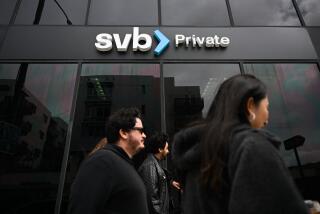Troubled Thrifts Still Pay Top Savings Deposit Rates
- Share via
Some of the nation’s most troubled thrifts--including some already under regulatory control--continue to pay among the highest rates for savings deposits, despite government efforts to curb the practice.
Industry experts contend that the higher rates often translate into higher costs for troubled thrifts, which could increase the tab for the taxpayer-financed federal bailout of the industry. In effect, taxpayers are subsidizing high rates to depositors at these ailing thrifts, experts say.
But regulators say there is little else that sick thrifts can do.
“The institutions need to maintain a certain amount of liquidity and the negative publicity that surrounds a takeover requires (that) they pay a little higher premium for deposits than their competitors,” said Dan Page, a spokesman for the Office of Thrift Supervision in San Francisco. “It is not the most desirable thing, but it is necessary under the circumstances.”
Still, the differences are sometimes staggering. An informal survey of 10 California thrifts--including five that meet capital requirements versus five that don’t--revealed that sick thrifts paid between 0.10 and 1 percentage point more than healthy institutions.
The highest rate payer locally is Valley Federal Savings & Loan, which is under tight operating restrictions because of its deteriorating financial health. It pays an annualized rate of 8.6% on both six-month and one-year jumbo certificates of deposit (those generally with balances of $100,000 or more), and will pay up to 8.71% if the depositor is over the age of 55.
By comparison, Great Western Bank, a Beverly Hills-based thrift that currently meets all regulatory requirements, pays only 7.72% for a six-month jumbo CD and only 7.95% for a one-year jumbo CD.
In other words, a saver with a $100,000 deposit would earn roughly $650 more each year by depositing the money in Valley Federal versus Great Western.
Gibraltar Savings, which is insolvent and currently under regulatory control, pays 8.59% for six-month jumbo CDs, while the other three troubled institutions surveyed--Columbia Savings, Mercury Savings and Imperial Savings--paid between 8.35% and 8.4%.
The healthy institutions surveyed--California Federal, Glendale Federal, Home Savings and World Savings--paid a maximum of 8.22% for six-month jumbo CDs.
Nevertheless, federal regulators maintain they have made progress in reducing the premiums sick thrifts pay for deposits. Two years ago, sick thrifts were paying between 0.25 and 0.35 percentage points more for deposits than average rates nationwide, said Eric Hirschhorn, director of industry analysis at the Office of Thrift Supervision in Washington. However, by the end of last year, that premium dropped to under 0.1 percentage point.
During the same period of time, the government has closed, sold or placed hundreds of sick thrifts under regulatory control. That cut the percentage of sick thrifts operating independently from 20% of the industry to less than 9%.
Although many insolvent thrifts under government control still pay higher rates, Hirschhorn notes that the government can ensure that those rates are not totally out of line. For example, the government can provide money to a troubled thrift, thereby reducing the institution’s need to pay high rates to attract deposits.
That’s helped both solvent and insolvent thrifts, he said. The interest that savings institutions pay on deposits is generally one of their biggest operating expenses, so any reduction in these rates often filters down to higher bottom-line profits. And because savings deposits of $100,000 and less are federally insured, competition forces healthy thrifts to keep their rates competitive with their weaker brethren.
Still, many healthy thrifts are dissatisfied with the fact that sick institutions are still allowed to pay these high rates.
* LURING DEPOSITORS
Columbia S&L; will refund early-withdrawal fines. D2
More to Read
Inside the business of entertainment
The Wide Shot brings you news, analysis and insights on everything from streaming wars to production — and what it all means for the future.
You may occasionally receive promotional content from the Los Angeles Times.










